11 Best DashThis Alternatives in 2026 [FULL Comparison Table]
DashThis is a great reporting tool for freelancers and small agencies—but it quickly becomes limiting as your business grows.
To help you find the best DashThis alternative, we scoured online reviews and talked to marketers, and came up with this list of 11 tools.
In this article, we’ll take you through:
- The shortcomings of DashThis
- 11 best DashThis alternatives
- Key features and pricing of each tool

Jan 02 2026●10 min read
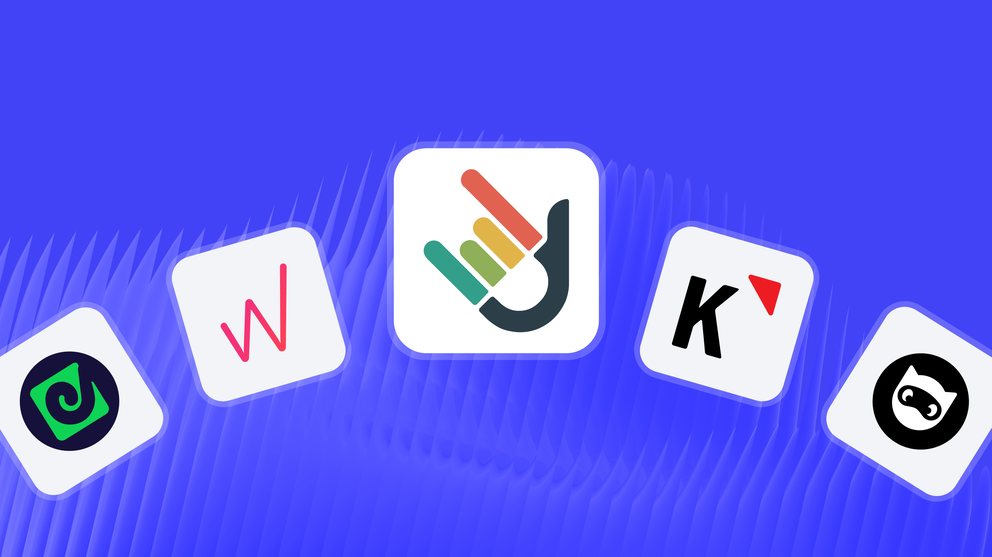
The biggest complaint we hear about DashThis from ex-users and online reviews is that it’s very limited. Here are a few ways how:
❌ Limited integrations: DashThis only offers 30+ native integrations, which doesn’t include important channels like Salesforce, Shopify, and Google DV360. You can upload your own data via CSV files or Google Sheets, but this creates more work and takes longer time to implement.
❌ No advanced data transformations: Apart from a “Merge” widget, DashThis doesn’t offer advanced data calculations or organization features. You can’t blend data sources together, make custom metrics and dimensions, or organize your data sources through custom tags.
❌ Limited visualizations: You can only create a dashboard on DashThis using a few pre-set templates. This makes it difficult to customize your dashboard according to your or your client's preferences. Online users also say the interface is clunky and it's difficult to move widgets and tables around.
❌ No AI insights: You need to summarize each report manually to unearth actionable insights and next steps.
❌ No data transfers: DashThis is purely a visualization tool—you won’t be able to ship your data to data warehouses or spreadsheets.
___
If you’ve outgrown DashThis, we’re here to help.
In this article, we’ll take you through 11 best DashThis alternatives that come with a wider selection of integrations, advanced analytics, and customization options.
11 Best DashThis Alternatives and Competitors in 2026
In a nutshell, here are the 11 best DashThis alternatives and competitors we’ll review in this article:
- Whatagraph
- Geckoboard
- Klipfolio
- NinjaCat
- Looker Studio
- Databox
- Funnel
- Supermetrics
- Adverity
- Improvado
- FiveTran
Don’t want to read through walls of text? Here’s a summary table:
| Features |
|

|

|

|

|

|

|

|

|

|

|
|---|---|---|---|---|---|---|---|---|---|---|---|
| Ease of Use | Easy | Easy | Hard | Medium | Hard | Medium | Medium | Hard | Medium | Medium | Medium |
| No. of out-of-the-box Data Connectors | 55+ | 90+ | 130+ | 150+ | 21 | 100+ | 500+ | 150+ | 600+ | 500+ | 400+ |
| Custom API Access |
|
|
|
|
|
|
|
|
|
|
|
| Data Blending |
|
|
|
|
|
|
|
|
|
|
|
| Custom Metrics and Dimensions |
|
|
|
|
|
|
|
|
|
|
|
| Custom Reports and Dashboards |
|
|
|
|
|
|
|
|
|
|
|
| Campaign Overview and Monitoring |
|
|
|
|
|
|
|
|
|
|
|
| White-labeling |
|
|
|
|
|
|
|
|
|
|
|
| Data Update Frequency | Every 30 mins across all integrations and pricing plans | Depends on data source, from 1 to 60 minutes | Depends on your pricing plan, from 4 hours to 30 minutes | Every day or manual data refresh | Depends on APIs, from 15 mins to 4 hours | Depends on APIs and your pricing plan, from 1 to 24 hours | Depends on the data source | Depends on the data source--mostly 1 to 3 days | Default is once every day but you can schedule "fetches" to be more frequent | Depends on the pricing plan--twice daily, four times daily, or custom | Depends on the pricing plan and data source, from 15 mins max to 1 min max. Default is 6 hours. |
| Data Segmentation and Filtering |
|
|
|
|
|
|
|
|
|
|
|
| Alerts and Notifications |
|
|
|
|
|
|
|
|
|
|
|
| Multi-Client Management |
|
|
|
|
|
|
|
|
|
|
|
| User Management | Admin, Manager, or Editor roles | Admin and View Only roles | Account Administrator, Klip Viewer, Klip Editor | System Admin, Standard User, Restricted Partner, Dashboard User, Account Executive, and more | Viewer, Editor, or Owner roles | Administrator, Editor, User, or Viewer roles |
|
|
Workspace admin, Dashboards, Explore, Manage, Shared dashboard viewer + custom roles | Viewer, Editor, Workspace admin, Data manager, Data load manager, Data analyst | Account administrator, analyst, billing, reviewer + custom roles |
| Automated Report Sharing |
|
|
|
|
|
|
|
|
|
|
|
| Data Export | PDF, XLS, CSV |
|
Export dashboards as PDF or image files. Export only individual Klips as CSV | Email, PDF | Google Sheets, CSV, Excel (only chart level) | PDF, JPG | JSON, CSV | Google Sheets, Excel, Monday, PowerBI, SupermetricsAPI | PNG, JPG, PDF, ZIP, PPTX, XLSX | JSON | |
| AI Insights |
|
|
|
|
|
|
|
|
|
|
|
| Customer Support | Live chat, email, Help Center for all pricing plans | Live chat, Email, Help Center | Email, Help Center | Live chat, Email, Help center, Academy | Help center, community forums | Live chat, email, Help Center | Email, In-app messages, Help center | Ticket-based support, Help Center | 24-hr Help desk, Help center, video guides | Service desks to raise requests, Help center, Email | 24/7 email support, Support portal, Help center |
| Dedicated Customer Success Manager |
|
|
|
|
|
|
|
|
|
|
|
| Data Security and Compliance | ISO 27001, Enterprise SSO, GDPR compliant, AES-256 encryption, Two-factor authentication, AWS hosted servers | AWS hosted servers, HTTPS (128-bit TLS), RBAC, PCI DSS compliant | AWS hosted servers, 2048-bit RSA key access for servers, no passwords, SSL, RBAC | GDPR complaint, DDOS protection, data encryption, MFA, RBAC | ? | ISO 27001, GDPR complaint, SSL encryption, passwords stored in virtual vault | ISO 27001 certified, GDPR and CCPA compliant, SOC 2 Type II | SOC 2 Type II, GDPR, and CCPA compliant, PCI-DSS, ISO27001, SSL encryption | Two-factor authentication, SSO, ISO-27001 certified, SOC 2 Type 2 audited, Fully protected API connections using SSL/TLS protocols, GDPR compliant | SOC 2 Type II, HIPAA compliant, GDPR and CCPA compliant, SSO | SOC 1 & SOC 2, GDPR compliant, HIPAA BAA, ISO 27001, PCI DSS LEVEL 1, HITRUST, SSO |
|
Pricing
(with $$$ being the highest)
|
$ | $ | $$ | $$ | Free for native connectors | $ | $$ | $$ | $$ | $$ | $$ |
Let’s dive into each of these tools.
1. Whatagraph
Most suitable for: Marketing agencies and in-house teams that manage multiple clients or brands, need cross-channel performance reporting, and want to save hours with AI automation
Whatagraph is the easiest AI-powered marketing intelligence platform that turns complex marketing data into clear insights, instantly.
Marketers use Whatagraph to connect all their channels, centralize reporting, and share impactful results—without needing technical expertise.
In a nutshell, here’s how Whatagraph works:
- Connect to 55+ marketing platforms automatically via native, stable connectors that don’t break.
- Easily organize your data—create custom blends, metrics, and dimensions using no-code workflows or AI.
- Ask AI to create reports by just telling it what you want it to build. Or use drag-and-drop widgets or ready-made templates to build one from scratch.
- Customize reports by just uploading a screenshot of your (or your client’s) brandbook or putting in a prompt. Host and share reports on your own domain.
- Get actionable insights instantly by just asking AI any questions about your connected data. Get it to write performance summaries directly in your reports in four different formats and 18 languages.
- Share reports as live links, PDFs, Excel spreadsheets, or automated emails. Transfer your data to BigQuery data warehouse or Looker Studio.
But how does Whatagraph compare against DashThis exactly? Let’s take a look:
DashThis vs. Whatagraph: Head-to-Head Comparison
Our Product team did extensive research on how Whatagraph compares against DashThis and you can find the full breakdown here.
In a nutshell, here are five key ways Whatagraph outperforms DashThis:
#1. More integrations with your favorite channels
While DashThis offers 30 native integrations, Whatagraph offers 55, including:
- Analytics: Google Analytics 4, Matomo, Piwik Pro
- PPC: Google Ads, LinkedIn Ads, Facebook Ads
- Social Media: Facebook, Instagram, LinkedIn
- SEO: Ahrefs, Google Search Console, Accuranker
- eCommerce: Shopify, WooCommerce, BigCommerce
- Email Marketing: ActiveCampaign, Klaviyo, Mailchimp
Explore all integrations here.
We’re also constantly adding new integrations—please reach out to us to see if we have one you need.
Being able to integrate with more marketing channels on Whatagraph means:
✅ You spend less time buried in CSV files and spreadsheets.
✅ You get a true, comprehensive picture of your overall marketing performance on one platform.
✅ There are less chances of human errors like data inconsistencies, duplicates, and missing records.
You can also easily bring in your own data via Custom APIs, Google Sheets, or BigQuery.
In comparison, DashThis offers custom integrations only via CSV File and Google Sheets. However, compared to APIs, CSV files are:
- Time consuming—you’ll need to manually download CSV records from your source platform and manually upload them
- Static—CSV files don’t refresh automatically
- Prone to errors
Plus, the integrations we provide at Whatagraph are fully-managed. This means they’re more seamless, stable, and accurate. And our Product engineers regularly maintain these integrations so you don’t have to.
If there are bugs, our Product team can resolve them quickly without having a third-party company involved.
Our users love how seamless and stable connections are on Whatagraph. Here’s what Tanja Keglić, Performance Marketing Manager at Achtzehn Grad, says:
We don’t have any connection issues on Whatagraph at all. We just connected the platforms once, and that was it. Whatagraph is also very quick when loading the data.
#2. Powerful AI to save you time and energy
At Whatagraph, we’ve launched a full suite of AI features—Whatagraph IQ— to create, style, and analyze reports in seconds. Here’s what we mean:
- Report creation in seconds: Just type what you need, and IQ builds a complete, multi-tab report for you. You can even ask it to add new tabs or create specific widgets on the fly.
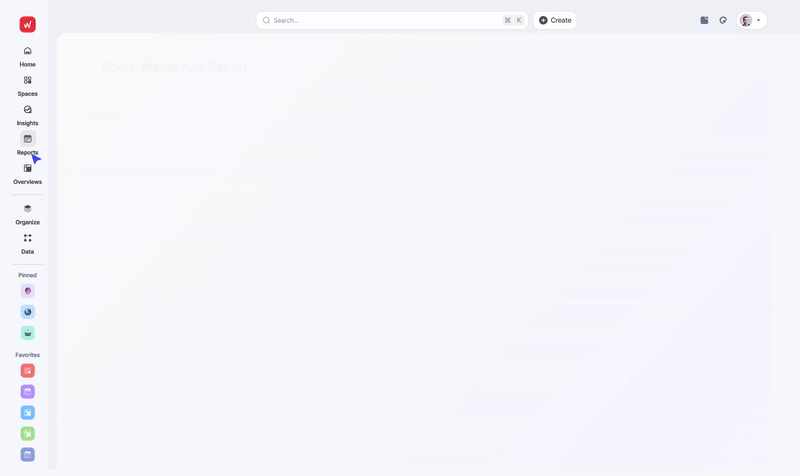
- Instant branding: Upload a logo or image, and IQ generates a matching theme with fonts, HEX colors, and icons. Every report looks professional and on-brand without extra design work.
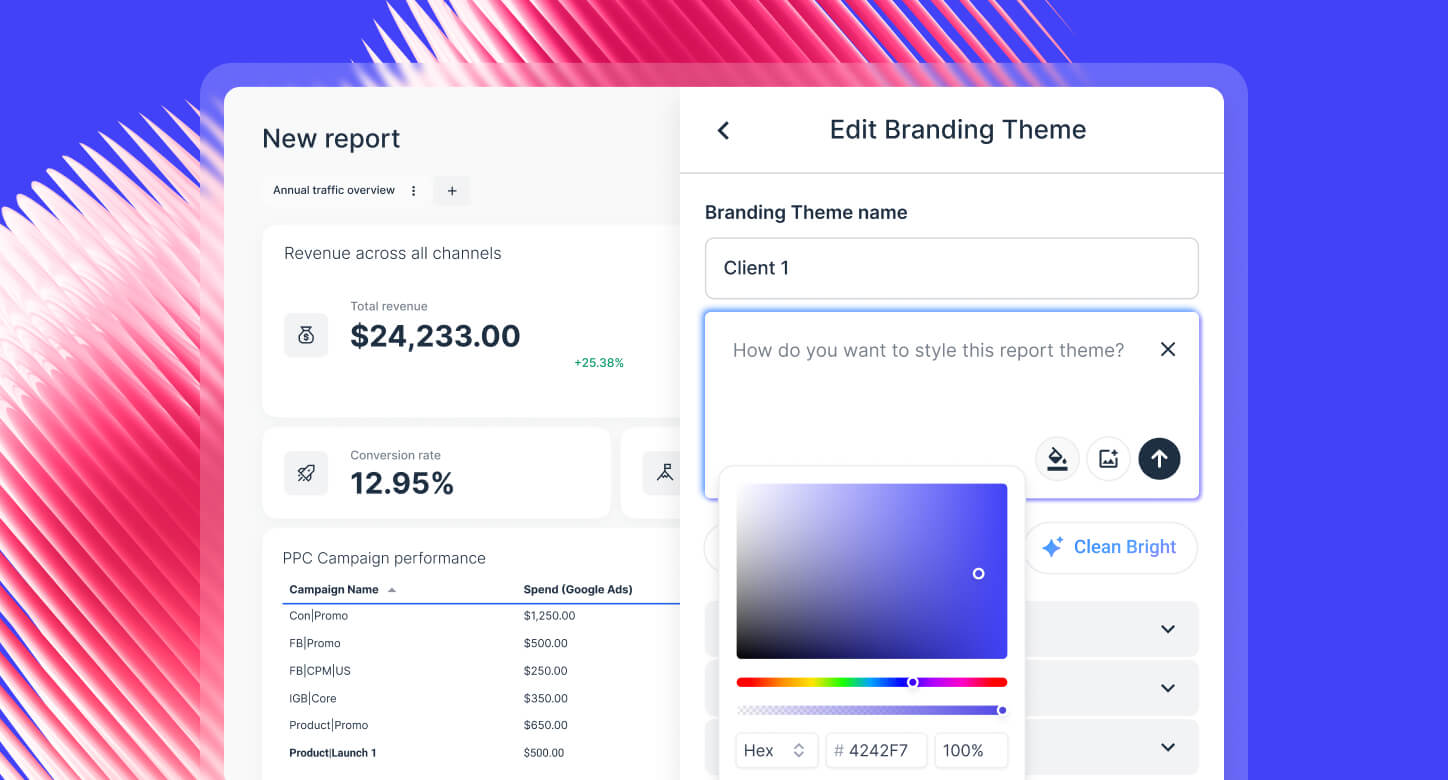
- Automated insights: Whatagraph IQ writes clear, plain-English performance summaries for each report—perfect for client presentations and internal reviews. Instead of manually typing explanations, you get client-ready insights instantly.
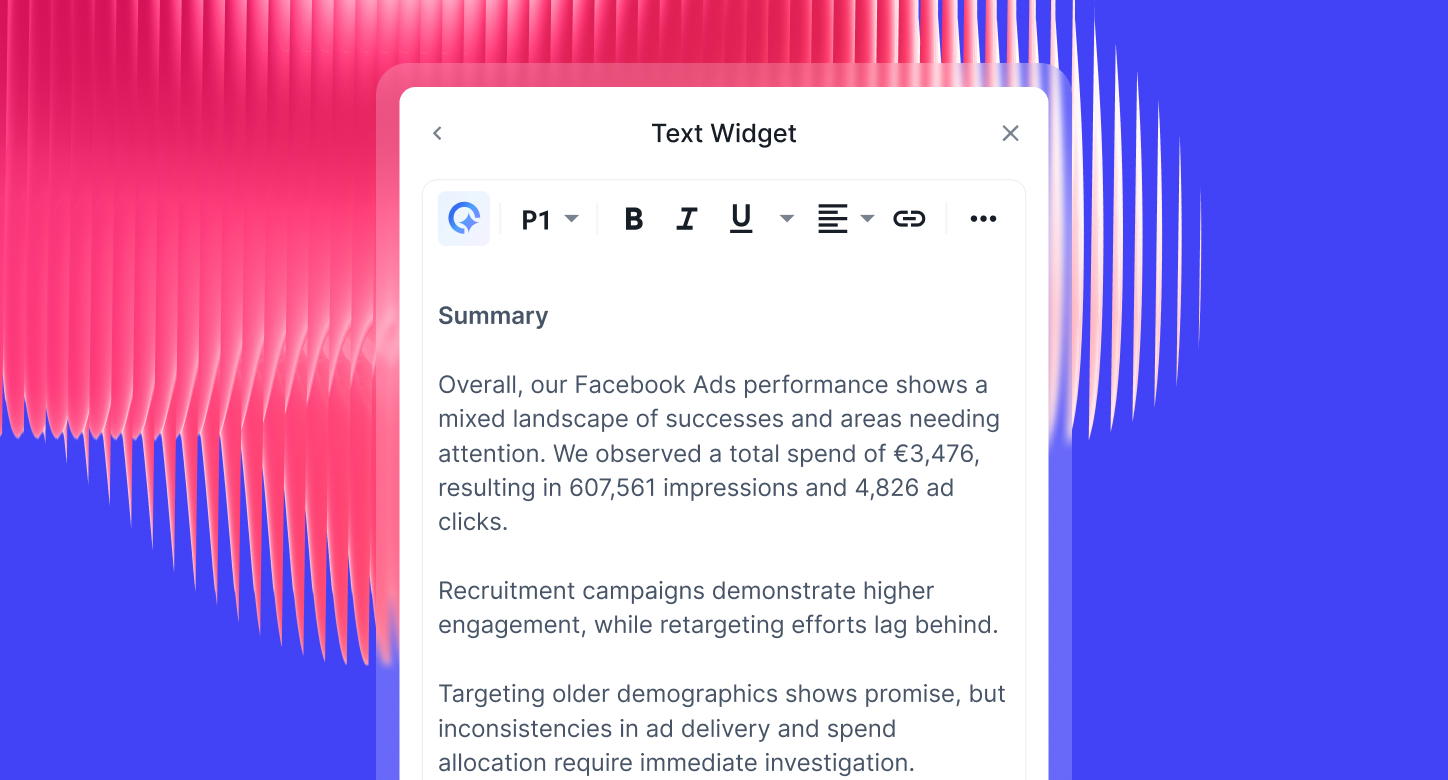
- Ad-hoc answers: With IQ Chat, you (and your clients) can ask questions like “Which campaign had the best ROI last month?” or “Where did our CPA spike?” and get instant answers based on your data.
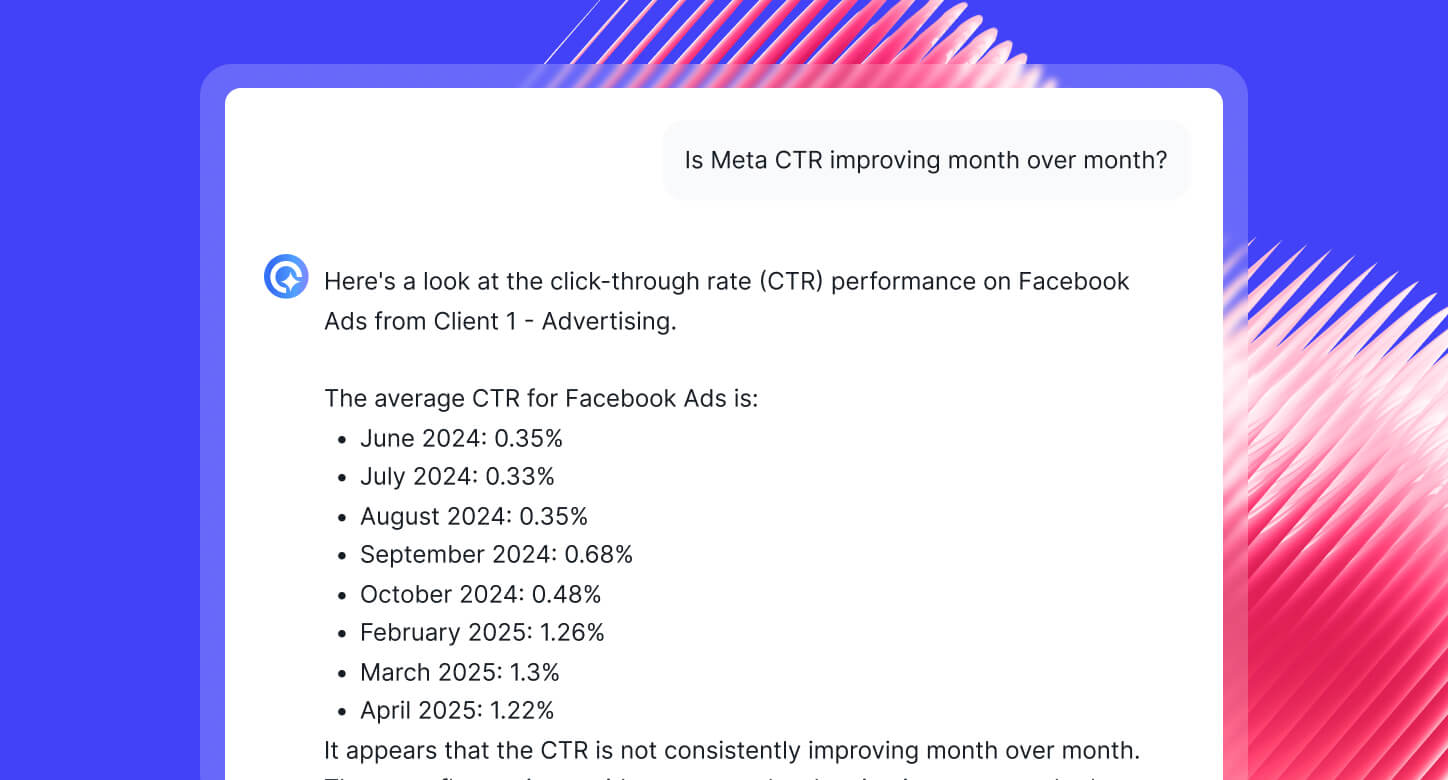
Get started with Whatagraph for free.
Thanks to these AI features, agencies like Maatwerk Online are saving 100 hours per month on reporting. Lars Maat, Co-founder of Maatwerk Online, says:
Whatagraph’s AI saves time and energy for our marketing specialists. And the hours we’re saving is just pure profit. We now have the time to focus on more strategic things that help both our agency and our clients grow.
#3. Easy data organization without codes
DashThis comes with a basic “Merge” widget where you can combine metrics from different sources to create a new one (e.g. Facebook Ads Cost + Google Ads Cost = Total Ad Cost).
This works for small agencies or solo businesses, but quickly becomes chaotic if you have 100s of data sources.
That’s where Whatagraph comes in.
On Whatagraph, you’ll get an entire dedicated space for data organization, aptly called “Organize” where you can:
- Blend metrics and dimensions from different channels into unified metrics
- Create custom formulas
- Unify names
- Group data sources and metrics by campaigns or regions
- Save new metrics and formulas as templates to re-use the next time
For instance, say you want to show the ‘Total Ad Spend” across multiple PPC channels. All you need to do is create a custom metric like so:
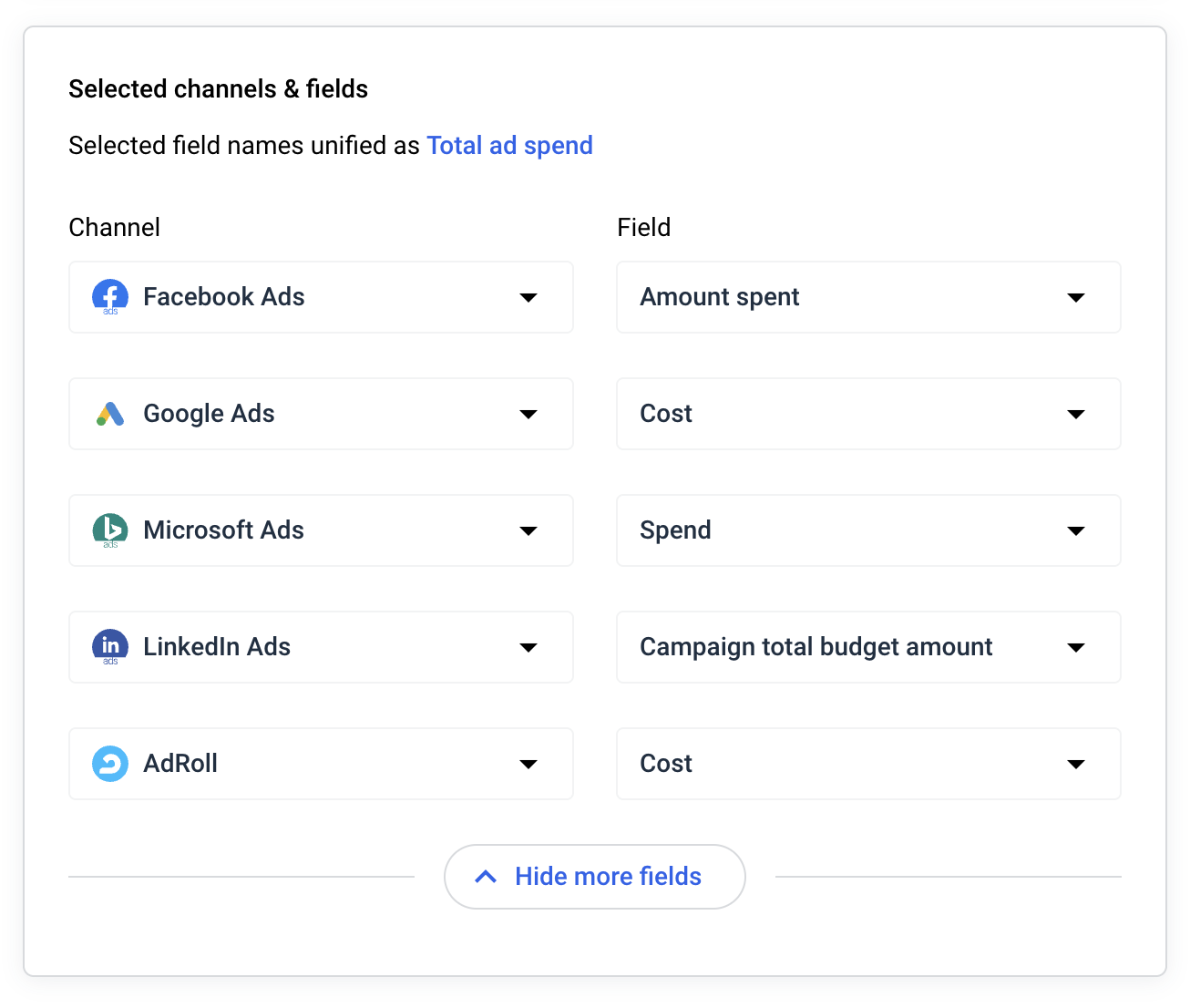
Then, you’ll get an aggregated metric of “Total Ad Spend” to add to your reports.
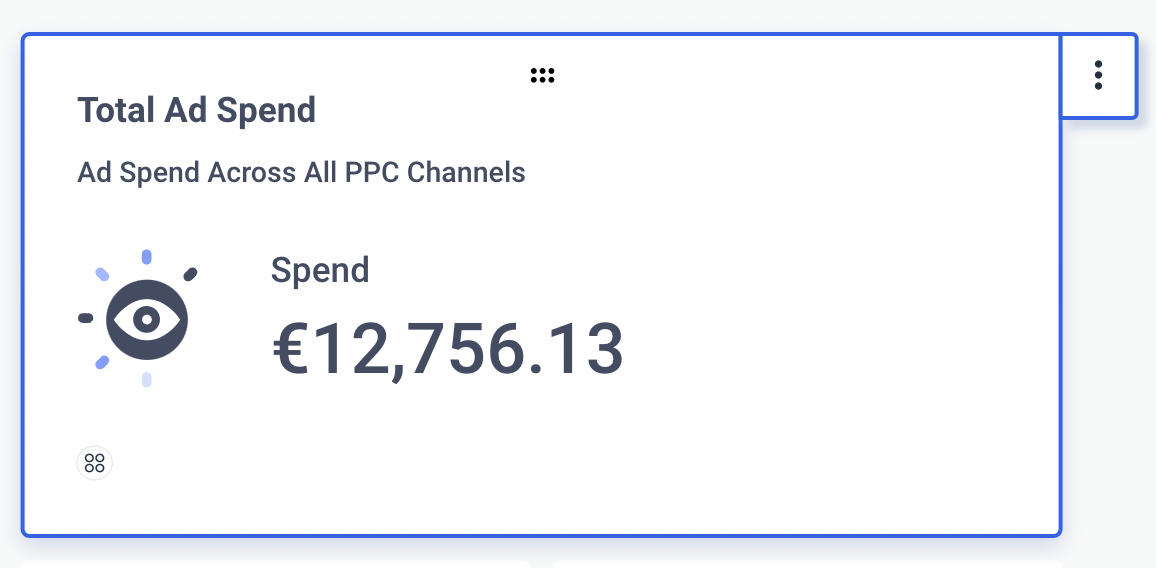
You can also combine data from completely different sources and channels. Say you want to blend data from Facebook Ads and Google Analytics 4. All you need to do is:
- Choose the data sources.
- Choose the dimensions and metrics you wish to use inside the blend.
- Select a join type.
- Give it a name and description.
And you can use the new blended source inside your reports right away.
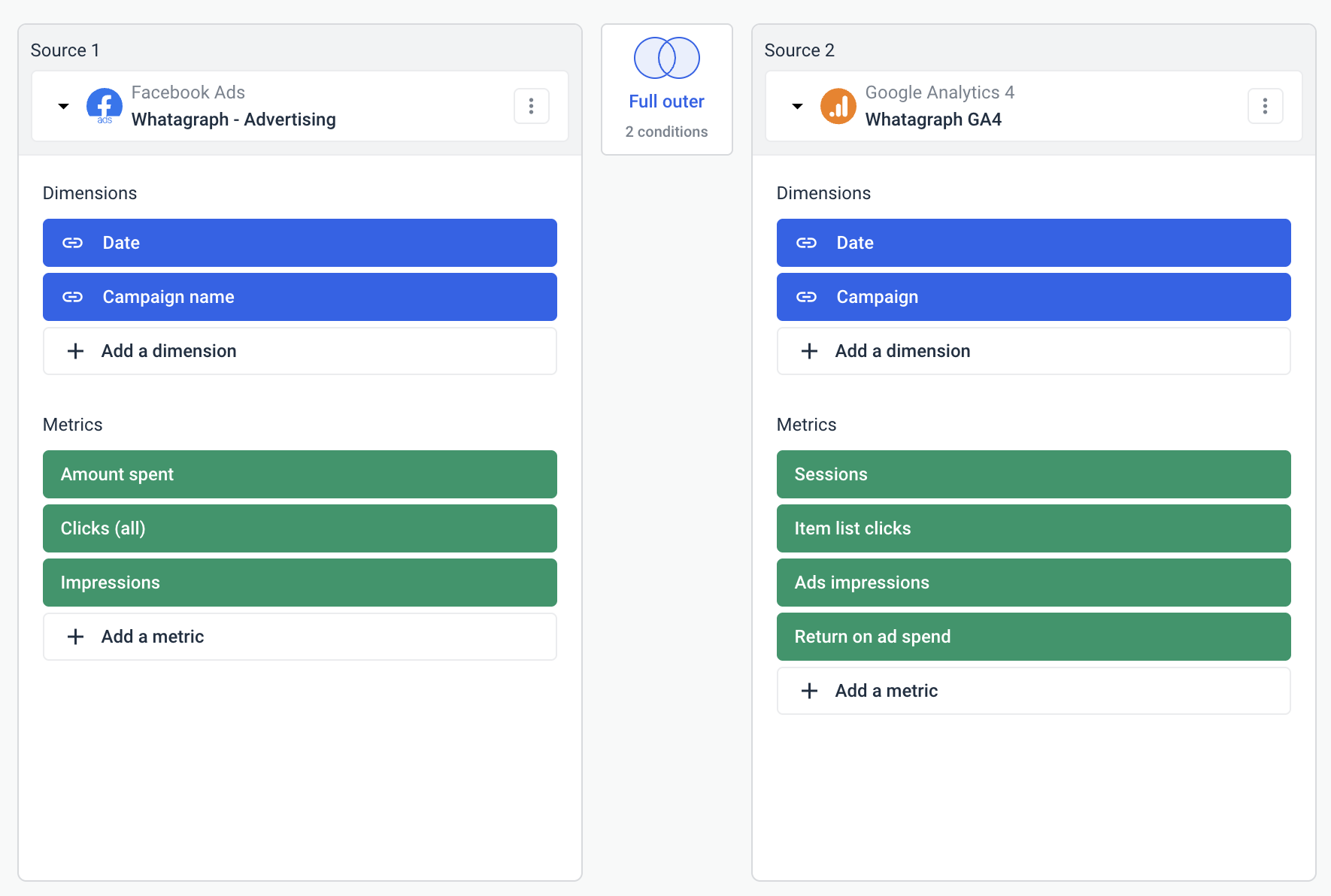
That's not all. On more advanced plans, you’ll get IQ Dimensions, where you can just ask AI to:
- Create custom blends automatically. Just describe what you need—like “combine all spend from Meta, TikTok, and Google Ads into one unified Paid Media metric”—and IQ builds the blend for you.
- Build custom metrics on the fly. Want ROAS across channels? Or a funnel KPI like Add-to-Cart conversions? IQ can generate them instantly, without formulas or coding.
- Standardize messy data with IQ Dimensions. For example, if you’ve got campaign names like “FB_US_SpringSale_23” and “MetaUSA_Spring23,” you can tell IQ: “Group by Campaign Type: Spring Sale”. IQ creates a brand-new dimension that neatly categorizes everything, and you can reuse it across reports.
- Normalize any dimension at scale. Group campaigns by objective, products by category, or reviews by language—whatever fits your reporting needs. IQ makes sense of inconsistent data and saves hours of manual clean-up.
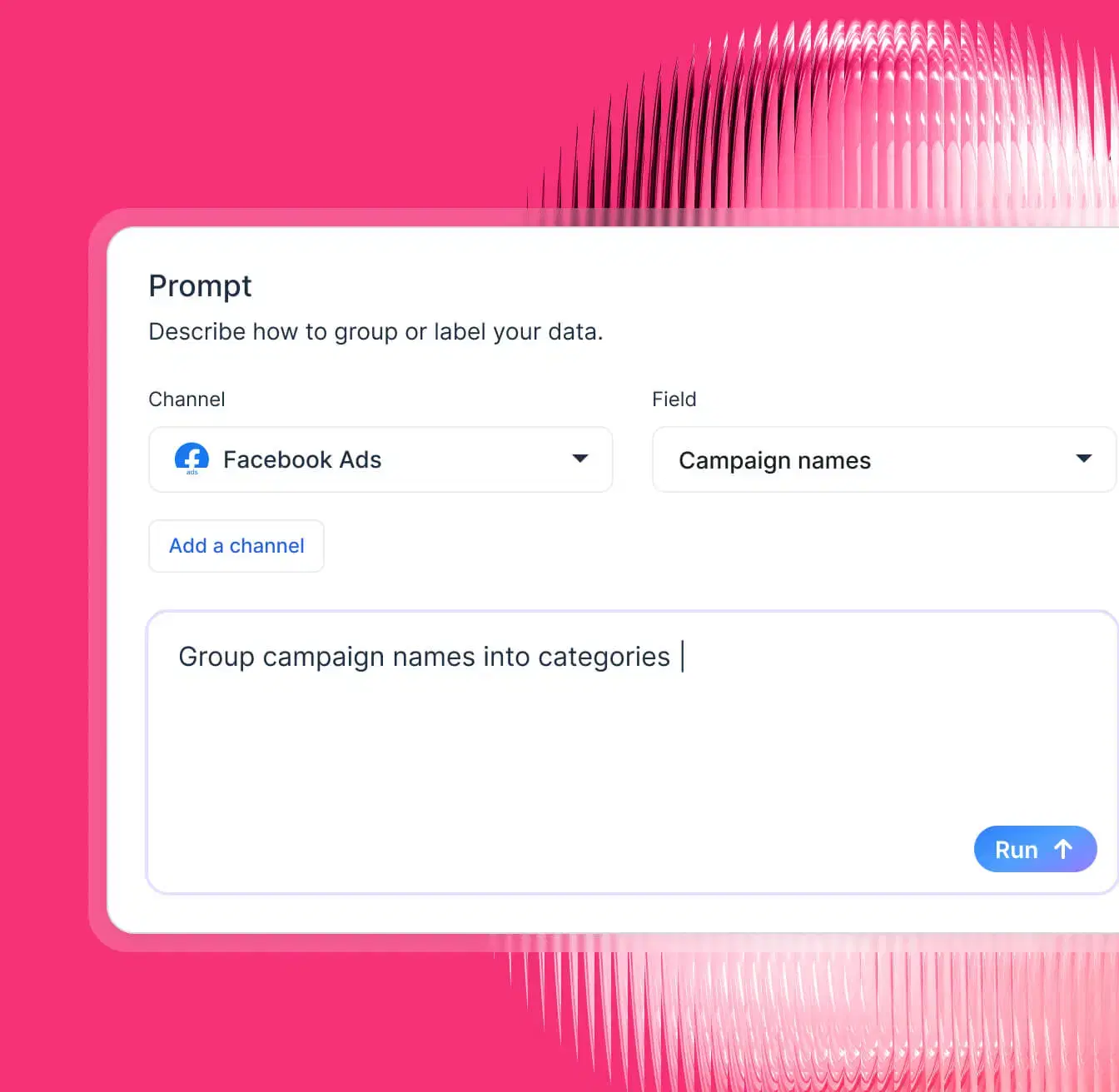
Powerful data organization on Whatagraph means:
✅ Your reports are easier to read, neat, and tidy.
✅ Your clients clearly see the value you’re delivering rather than being stuck interpreting data.
✅ You can analyze and compare performance any way you want, and use these insights to deliver better results for clients.
#4. Dynamic, fully white-labeled reports in seconds
DashThis' reports can be limited and static.
There’s no option to start from a blank dashboard and add your own widgets, tables, and charts in your own format. Instead, you’ll need to use pre-set templates, which aren’t very customizable.
Here’s what one user said on Capterra:

DashThis also lacks thoughtful customization features that make a huge difference in user experience. For instance:
❌ You can only resize widgets vertically, not horizontally.
❌ You can’t add new rows to add more metrics.
❌ You can’t change the orientation (horizontal vs. vertical) of your reports.
❌ You can’t adjust column widths on tables.
In comparison, Whatagraph’s dashboards and reports are highly dynamic and customizable.
For instance, Whatagraph IQ, you can just create a report with fully branded themes in seconds. Here’s how that works:
- Upload a logo or brand image, and Whatagraph builds a matching palette with fonts, HEX codes, and chart colors
- Or describe the style you want in plain language, and Whatagraph produces a ready-to-use theme
- Fine-tune the colors and fonts manually
- Save each theme as a “Global theme” so you (and your team) can re-use it across all reports
This means you deliver reports that look professionally designed, tailored to each client or brand, and consistent across campaigns.
Here’s an example of a Shopify report template:
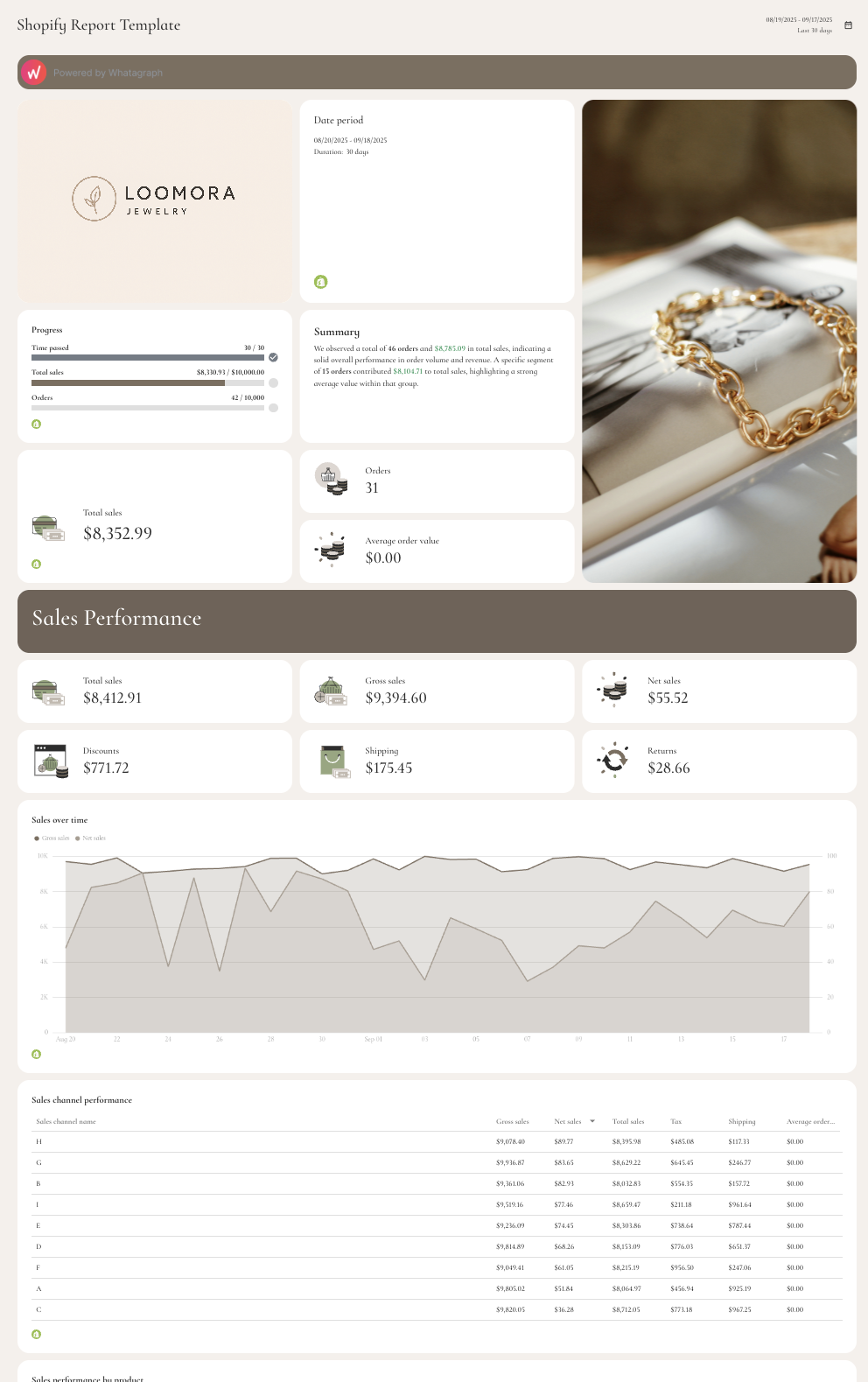
Here’s an example of a social media report template:
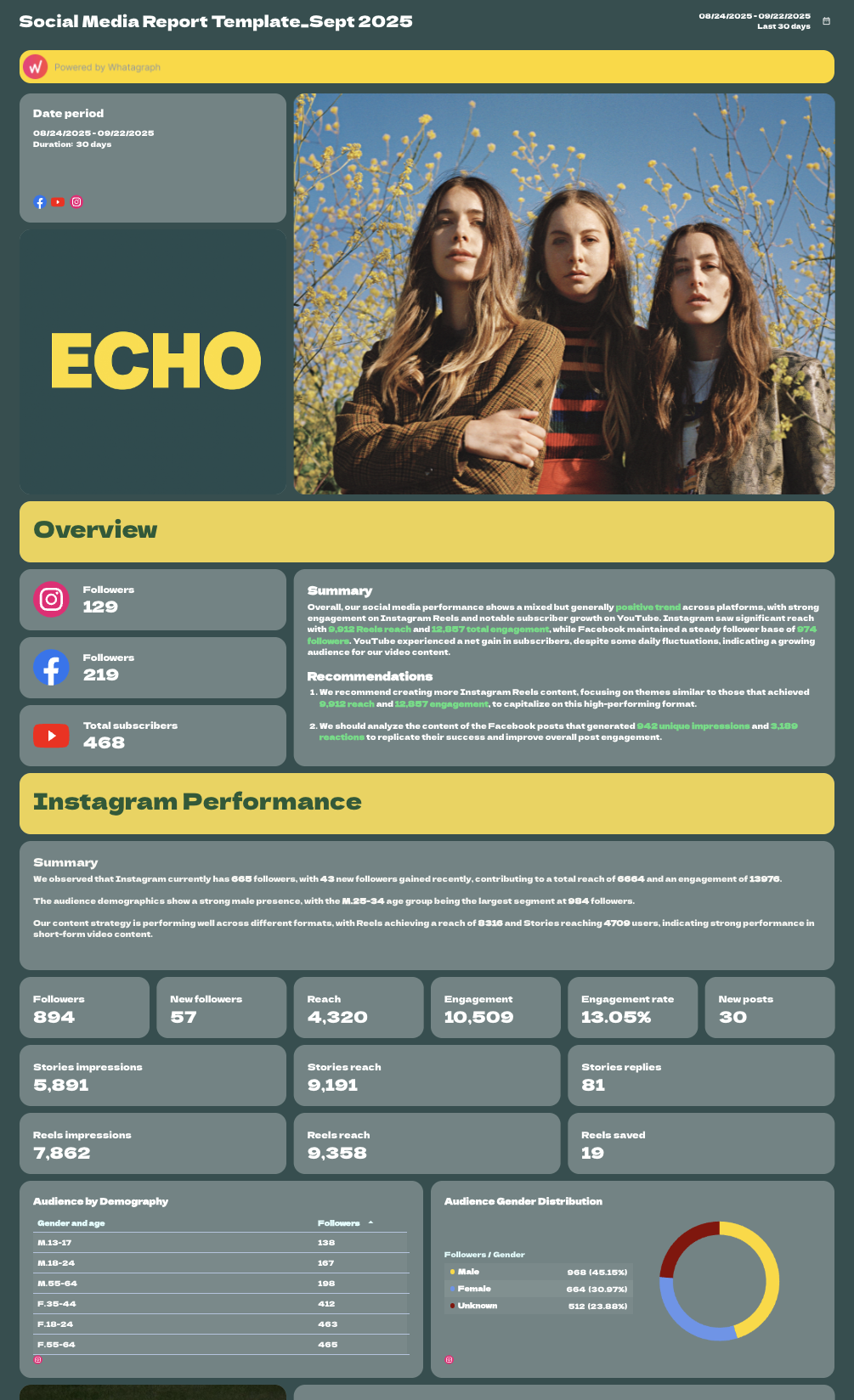
And here’s an example of a paid-per-click report template:
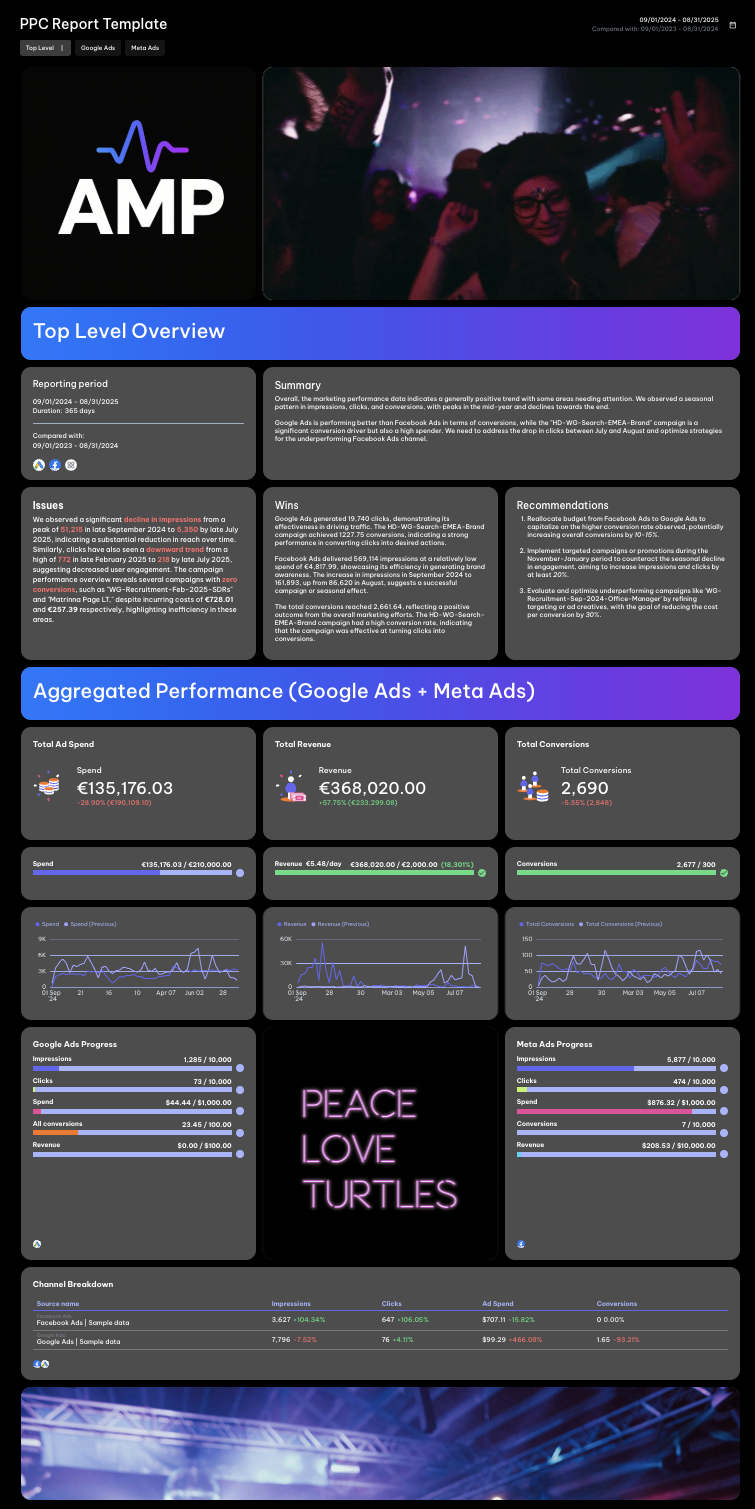
Start building your report for free with Whatagraph.
Whatagraph also comes with thoughtful design features that make your user experience smooth as butter. You can:
✅ Change the orientation of your reports as Landscape or Portrait
✅ Adjust the width and height of your charts and graphs right on the dashboard
✅ Save reports as “templates” and re-use them the next time
✅ Edit linked reports in one go, rather than one by one
✅ Add multiple “Tabs” within a single report to visualize performance from different channels or campaigns
Our customers love how simple and easy Whatagraph is to use. André Cardoso, Project and Performance Marketing Manager at Wise Pirates, says:
Whatagraph is really simple to use, intuitive, and perfect for marketing teams with limited technical knowledge.
When the time comes for sharing these reports, you can either:
- Set up automated emails to specific people at specific times, days, and cadence. Customize the email subject lines and copy.
- Send instant live links to anyone.
- Download PDFs or CSVs.
- Transfer your data to BigQuery.
#5. Straightforward pricing with more value
DashThis pricing starts at $45/month for the Individual plan, but you’re limited to just 3 dashboards.
To scale, you’ll need the Professional plan at $139/month for 10 dashboards, or the Business plan at $269/month for 25 dashboards. Every step up costs more—and you’re still capped on how many dashboards you can create.

Whatagraph takes a different approach. Pricing is based on source credits, which you use to connect and blend data. But no matter the plan, you always get:
- Unlimited dashboards
- Unlimited users
- Powerful AI features (Whatagraph IQ) baked in from day one
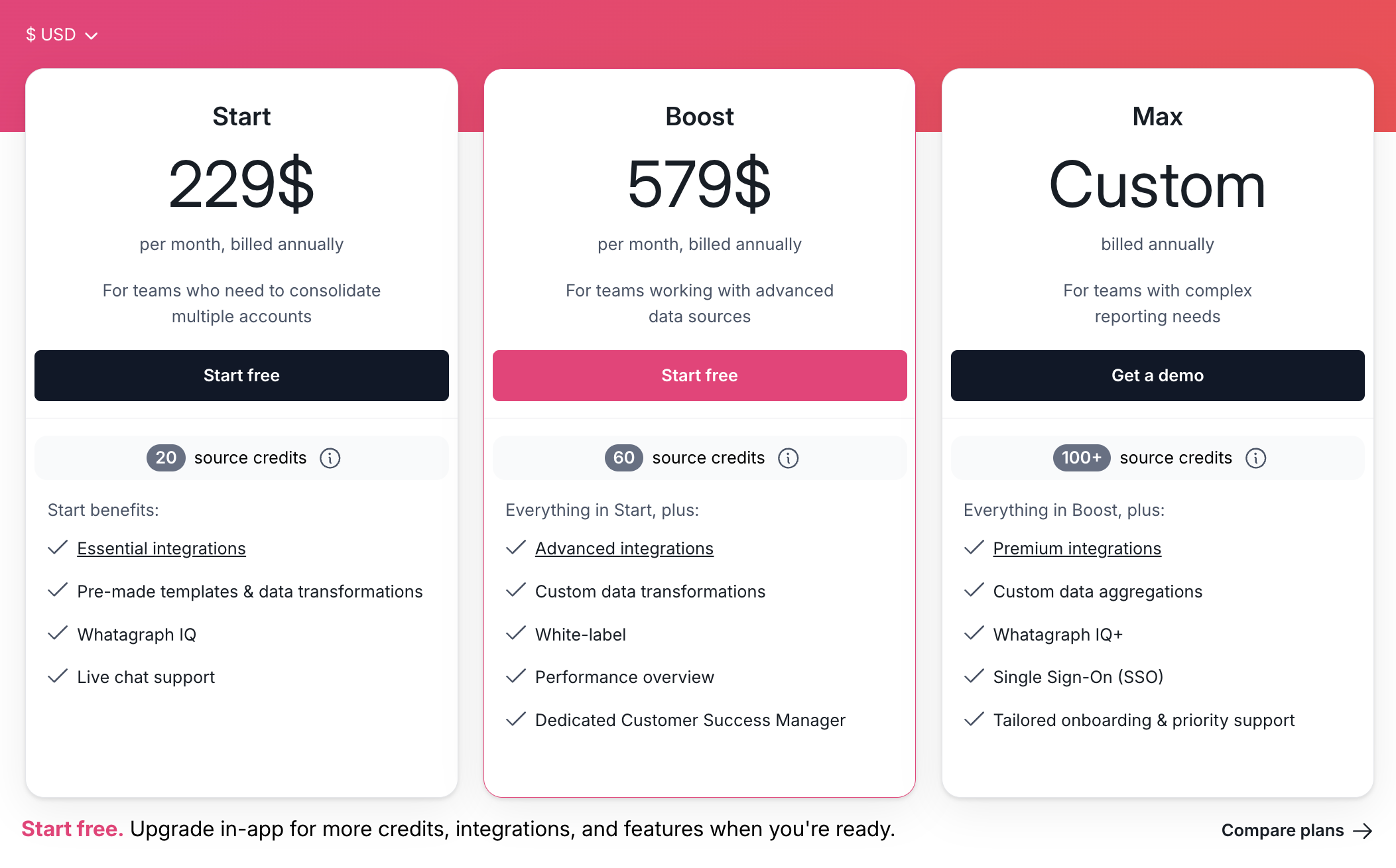
And while Whatagraph can be more expensive than DashThis, here’s where the value is significantly higher:
✅ Forever Free plan to test reporting with no time limits
✅ Unlimited dashboards and users on every paid plan
✅ Whatagraph IQ: AI report creation, insights, themes, chat, and summaries
✅ Advanced data blending + custom metrics without code
✅ Fully white-labeled, branded reports in seconds with IQ Themes
✅ 30-min data refresh on every plan
✅ Direct exports to warehouses (e.g. BigQuery) and BI tools (e.g. Looker Studio)
✅ Responsive live chat with <4 min reply time
Key Features
- 55+ stable native integrations across paid ads, social, SEO, email, and more
- Custom integrations via API, Google Sheets, or BigQuery
- Whatagraph IQ – AI-powered reporting tools
- Versatile drag-and-drop widgets for reports and dashboards
- Custom metrics, dimensions, and data blends
- Performance monitoring overview
- Library of pre-made dashboard and report templates
- Insights – automatic audits of connected data, anomaly detection, and recommendations
- Spaces – organize reports with descriptions, colors, and better team alignment
- Custom branding and white labeling
- Automated report sharing via email or live dashboard links
- Exports: PDF, Excel, CSV, or transfer directly to BigQuery/Looker Studio
Whatagraph Reviews from Real Users
“To me, Whatagraph is like the Tesla or Mercedes of digital analytics tools, their clean and simple way to present complex marketing data. I highly recommend it to anyone working with marketing analytics who values efficiency and clarity in their reporting.” (Source)
“Whatagraph has a simple user interface that is easy to navigate even for those who don't have analytical skills.” (Source)
“What I like best about Whatagraph is having the ability to create reports fast and easy. No more spreadsheets to do reports, they have a great variety of templates.” (Source)
Pros and Cons
Pros:
- All-in-one marketing performance monitoring and reporting solution
- Easy to use by anyone on your team
- Fast campaign performance and insights
- Stunning visual reports
- Makes results easy to interpret
- Excellent live chat customer support
Cons:
- Just one data warehouse destination (BigQuery) is available so far
Pricing
Whatagraph’s pricing is transparent and flexible, with plans based on source credits (how many platforms you connect and how much data you move) and the level of customization you need.
Here’s the breakdown:
- Forever Free – Get started at no cost with 5 source credits, Whatagraph IQ basics, pre-made templates, and live chat support. Perfect for testing reporting workflows without commitment.
- Start – $229/month (billed annually) – 20 source credits, essential integrations, Whatagraph IQ, pre-made templates & transformations, unlimited dashboards/reports, and live chat support.
- Boost – $579/month (billed annually) – 60 source credits, everything in Start plus advanced integrations, custom data transformations, white-labeling, performance overview dashboards, and a dedicated Customer Success Manager.
- Max – Custom pricing – 100+ source credits, everything in Boost plus premium integrations, advanced data aggregations, Whatagraph IQ+, SSO, tailored onboarding, and priority support.
2. Geckoboard
Most suitable for: Medium to large businesses in the Customer Service, Sales, and eCommerce sectors
Geckoboard is an easy to use dashboard building tool for Customer Service, Sales, and eCommerce businesses.
With it, you can connect to 90 data sources, design your dashboard, and share the dashboard with your team members or the C-Suite.
Geckoboard’s main advantage over DashThis is its wider variety of data sources (90 vs. 35). You can connect to major marketing platforms, as well as CRM, Sales, Finance, and eCommerce tools. Some examples include Shopify, Stripe, Dixa, Intercom, and Pipedrive.
However, some of these integrations (like Safesforce and Zendesk) are only available on pricier “Pro” plans.
Once your data is connected, you can create three main types of dashboards:
- A blank dashboard (similar to Whatagraph’s)
- TV dashboards for internal presentations
- Mobile dashboards
- Snapshots and reports
However, keep in mind that these dashboards are more suitable for businesses, such as “HR dashboards”, “Inventory dashboards” etc.
Another cool feature about Geckoboard is its “KPI notifications” which sends notifications when KPIs trend up or down via Slack.
However, unlike Whatagraph, you won’t be able to create custom data blends, metrics, and dimensions on Geckoboard. This can be a deal breaker if you’re a large company and you need to organize your scattered data to create easy to read and impactful reports.
Their dashboards are also quite basic and static with very few customization options. You also can’t ship your data to warehouses on Geckoboard.
Key Features
- 90+ integrations with Customer Service, Sales, Finance, and eCommerce channels
- Drag-and-drop dashboard builder
- KPI notifications
- Slack integration
- Automated email reports
- TV dashboards
- Mobile-friendly dashboards
- Dashboard examples for businesses
Geckoboard Reviews from Real Users
“I love how simple it is to use. That you can connect data from so many different sources in an easy way.” (Source)
“Connecting the dashboard with the Tv works like a charm.” (Source)
“Geckoboard could use more features and options for customization. Compared to other tools like Power BI or Tableau, Geckoboard didn't have as many advanced tools for analyzing data or changing how things looked. I wished I could make more complicated charts and do special calculations.” (Source)
Pros and Cons
Pros:
- Easy to use and set up
- A wide variety of integrations
- Great customer service
Cons:
- Can be pricey if you want to add more dashboards
- Limited customization options for dashboards
- No advanced calculations, blends, and custom metrics and dimensions supported
Pricing
Similar to DashThis, Geckoboard’s pricing is based on the number of dashboards. But unlike DashThis (which includes unlimited users), Geckoboard has limitations on the number of users.
As of October 2024, Geckoboard offers three pricing plans:
- Essential: $149/month for 5 dashboards, 3 users, 1 TV share, and core data sources
- Pro: $199/month for 5 dashboards, 10 users, 3 TV shares, and pro data sources
- Scale: $699/month for 30 dashboards, 25 users, 10 TV shares, pro data sources, and dedicated Support rep
3. Klipfolio
Most suitable for: Large data teams at companies and large agencies
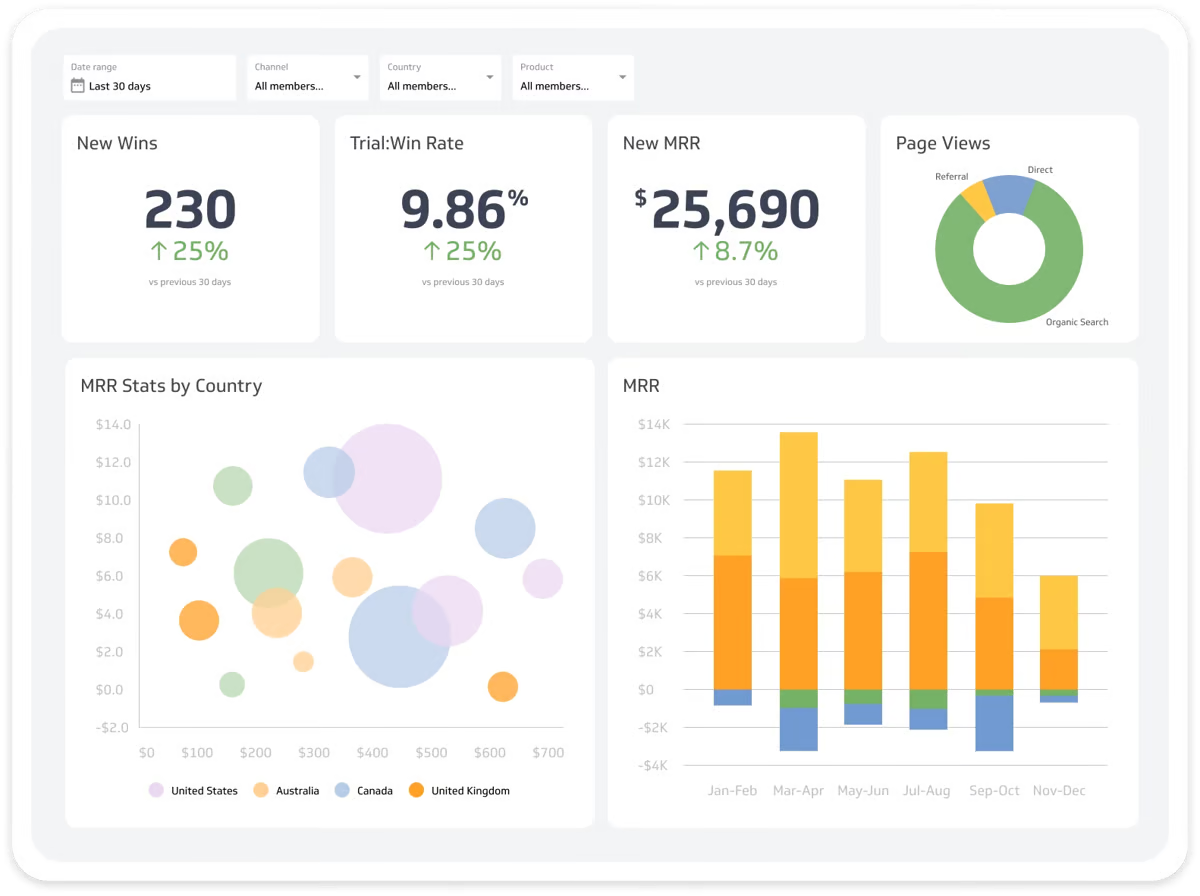
Klipfolio is a data analytics and a business intelligence tool in one. It offers two key products:
- PowerMetrics: Suitable for data teams at large companies, this is a data analytics solution to centralize, standardize, and share accurate metrics throughout the organization. Non-data teams can then use these certified metrics for their dashboards and reporting needs.
- Klips: These are your regular data visualization dashboards and reports. Klips integrates with 130+ platforms and you can also use a Rest/URL option for custom integrations.
Klipfolio is way more robust than DashThis. For instance, with Klips, you can:
- Pull data that's stored on premise or in the cloud, upload spreadsheets, or write custom queries
- Use Excel-like formulas and functions to transform your data, perform calculations, and more
- Get real-time data refresh on your dashboards
However, Klipfolio is not as easy to use as DashThis. You need a lot of coding knowledge to build connections with channels and customize your dashboards.
Key Features
- 130+ integrations including warehouses, SQL databases, and file-sharing services
- Data blending, unifying, aggregating
- Custom metrics and dimensions
- AI insights
- Custom dashboards and reports
- Export dashboards as PDF or image files. Export only individual clips as CSV
- Scheduled reports
Klipfolio Reviews from Real Users
“Klipfolio has a user-friendly interface. It can be easily connected with databases, Excel sheets, and Google sheets which makes data integration very smooth and easy.” (Source)
“I love the full range of capabilities that are possible when building a Klipfolio dashboard (specifically with their Klips product).” (Source)
“Every time I contact support I get the impression that I am bothering them. I will not be renewing this platform because I do not feel valued as a customer.” (Source)
Pros and Cons
Pros:
- Powerful data analytics and organization options
- AI insights to help make data-driven decisions
- Highly customizable
Cons:
- Can be difficult to set up and use
- Expensive with important features only available as add-ons or in Enterprise plans
- Unhelpful customer support
Pricing
Klipfolio offers three pricing plans for two of their products: PowerMetrics and Klips.
As of October 2024, here are the plans for PowerMetrics:
- 30-day free trial
- Professional: $300/month for 10 users and unlimited metrics.
- Enterprise: Custom pricing for 10 users, unlimited metrics, and priority support.
It’s also important to note that important features like data warehouse integrations, AI insights, and custom domains are only available as add-ons, unless you purchase the Enterprise plan.
Klips’ pricing is further divided into plans for businesses and for agencies.
As of October 2024, here are the plans for businesses:
- Grow: $190/month for 15 dashboards and 1 hr data refresh rate. No priority support or custom onboarding available.
- Team: $350/month for 30 dashboards and 15 min data refresh rate. No priority support or custom onboarding available.
- Team+: $690/month for 60 dashboards and up to the minute data refresh rate. Includes priority support and custom onboarding
As of October 2024, here are the plans for agencies:
- Agency Lite: $190/month for 20 dashboards, 20 clients, and 1 hr data refresh rate. No priority support or custom onboarding available.
- Agency Pro: $420/month for 40 dashboards, 40 clients, and 30-min data refresh rate. No custom onboarding available.
- Agency Premier: $1025/month for 70 dashboards, 70 clients, and 30-min data refresh rate.
Side note: On Whatagraph, you can get unlimited dashboards, unlimited clients, 30-min data refresh rate, priority support, and custom onboarding on ALL our plans. Reach out to us for a pricing plan just for you.
4. NinjaCat
Most suitable for: Marketing agencies and brands with dedicated data scientists
NinjaCat is an end-to-end platform for connecting to your data sources, cleaning the data, visualizing it, and shipping it to destinations.
You can integrate with 100+ pre-built connectors, ranking from CRM, search advertising, web analytics, and project management tools.
You can then simplify and harmonize your data with no-code transformations and custom calculations. There’s also the option to store your data in a managed warehouse.
Or, you can ship your data to external storage destinations like Snowflake, BigQuery, or Amazon S3, or business intelligence destinations like Tableau and Looker Studio.
When it comes to creating reports, you can start from a blank template (that looks like a “canvas”) and add and adjust metric widgets as needed.
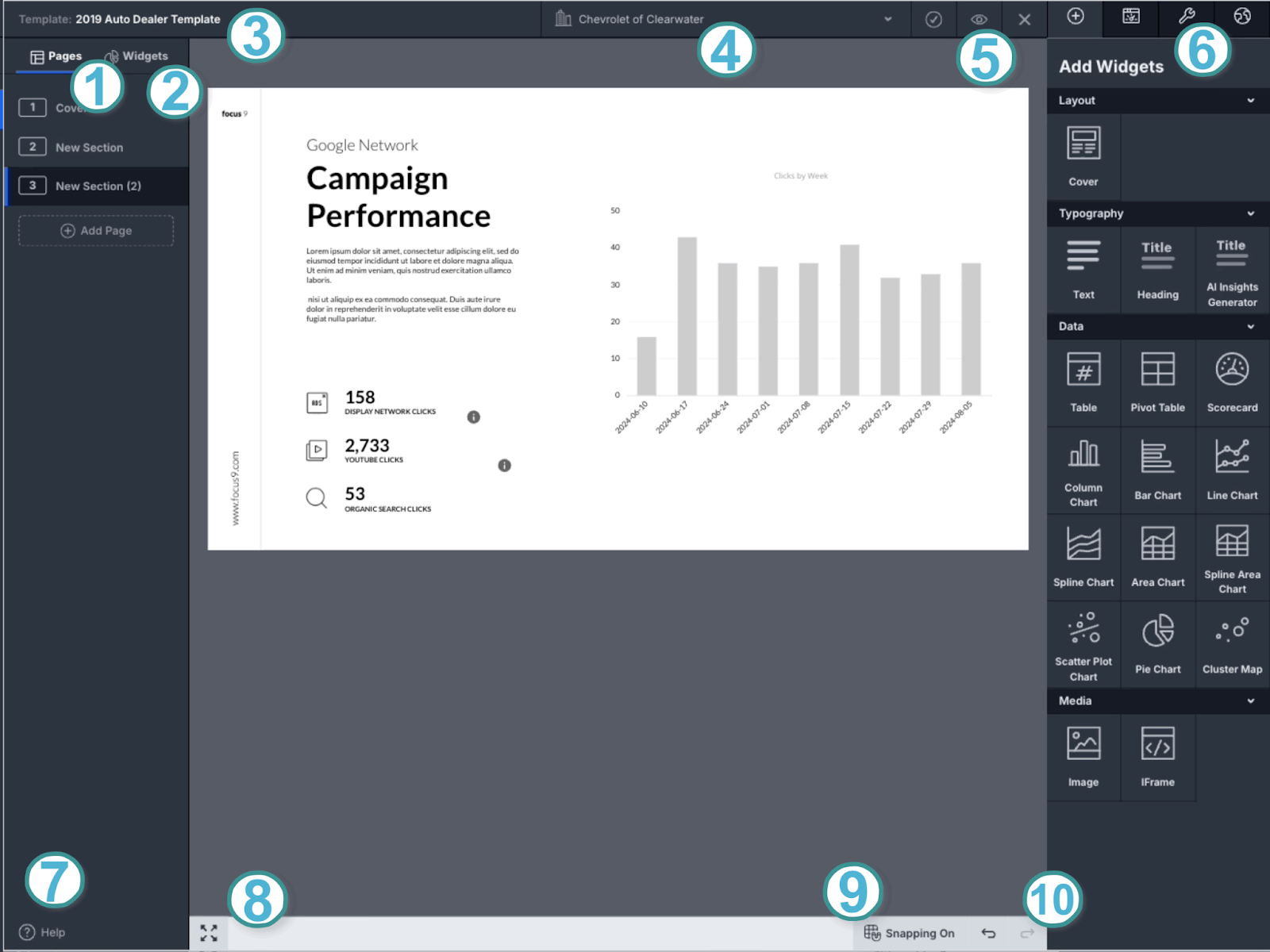
Graphic designers will be familiar with this layout as it looks a lot like a popular design tool—Figma. However, if you’re a marketer without a design background, this interface can be quite confusing and overwhelming.
Key Features
- 100+ pre-built connectors
- No-code transformations and calculations
- Data transfer to BI tools and data warehouses
- Easy ad spend and campaign performance monitoring
- White-label options
- White-glove setup and service
NinjaCat Reviews from Real Users
“I love how it pulls in our data across several different platforms into one cohesive report.” (Source)
“The support the NinjaCat provides is exceptional.” (Source)
“I found a lot of the functionality on Ninjacat to be really clunky, unfortunately things take a LONG time to process if you're adding more than one filter to a table.” (Source)
Pros:
- Automated client reporting
- One platform for integration and visualization
- Multiple choice of destinations
- Custom branded reports
Cons:
- Separate workspaces to organize and visualize data
- Complex visualization builder
- Performance issues with reports
- No autosave in case of a crash
Pricing
NinjaCat doesn’t offer fixed pricing plans, and no information is available on its website.
5. Looker Studio
Most suitable for: Freelancers and boutique agencies
Google’s free reporting tool, Looker Studio, is a popular choice among marketers.
Looker Studio comes with 21 native integrations with Google-based platforms like Google Ads, DV 360, Google Sheets, and Google Analytics. You can also connect to BigQuery, MySQL, and Microsoft SQL servers on Looker.
Once your data sources are connected, you can use Looker’s drag-and-drop report editor to ad:
- Charts, line bars, pie charts, geo maps, area and bubble graphs, data tables, pivot tables
- Filters and date range controls
- Links and clickable images
- Custom text and images
- Custom styles and color themes
You can then invite teams or clients to view or edit your reports, or send them links in scheduled emails.
Looker Studio’s key advantage against DashThis is that it’s free—but only for Google-based platforms.
If you need data from additional SEO, social media, and paid media channels, you’ll need to buy third-party connectors and pay for monthly subscription plans.
Looker Studio also offers more advanced data calculations, like data blends, but they are limited to 5 data sources. (In comparison, there are no limits to blends on Whatagraph.)
However, Looker Studio can be slow and clunky, with many users complaining of connection breakages, slow load times, and inaccurate data.
Key Features
- 21 native connectors (free)
- 1000+ “partner” connectors (paid)
- Drag-and-drop report builder
- Data blends
- Custom images and text
- Custom styles and color schemes
- Mobile app
Looker Studio Reviews from Real Users
“I love the way you can present data from multiple sources in one report. I also love the ability to blend different tables and show the information in one chart.” (Source)
“Unfortunately, connectors break quite regularly and reports containing a lot of data can take a lengthy time to load.” (Source)
“Looker studio needs more report downloading options such as Word and PDF.” (Source)
Pros and Cons
Pros:
- Free (to an extent)
- A huge range of data visualization formats and options
- Easy to use for basic reports
Cons:
- Slow loading
- Connection breakages and inaccurate data
- Limited report sharing options (no Word, Sheets, or PDFs)
Pricing
Looker Studio is free for connections with 21 native integrations, which are mostly Google-based platforms.
6. Databox
Most suitable for: Boutique agencies and small businesses
Databox is a data reporting and analytics platform for growing businesses.
You can integrate with 100+ software tools, and bring in custom data through Google Sheets or Excel.
Then, you can visualize this data directly on Databox using pre-built metrics and templates.
One thing Databox offers that DashThis doesn’t is the Slack, email, or app updates when performance trends up or down on your tracked metrics.
You can also save important benchmark groups to track your metrics over time, or compare them with industry standards.
However, Databox users online say the platform is clunky and has an unappealing user interface. For instance, in the screenshot below, you’ll see that your data is visualized in a “box” format and the metrics look “squished” together and hard to read.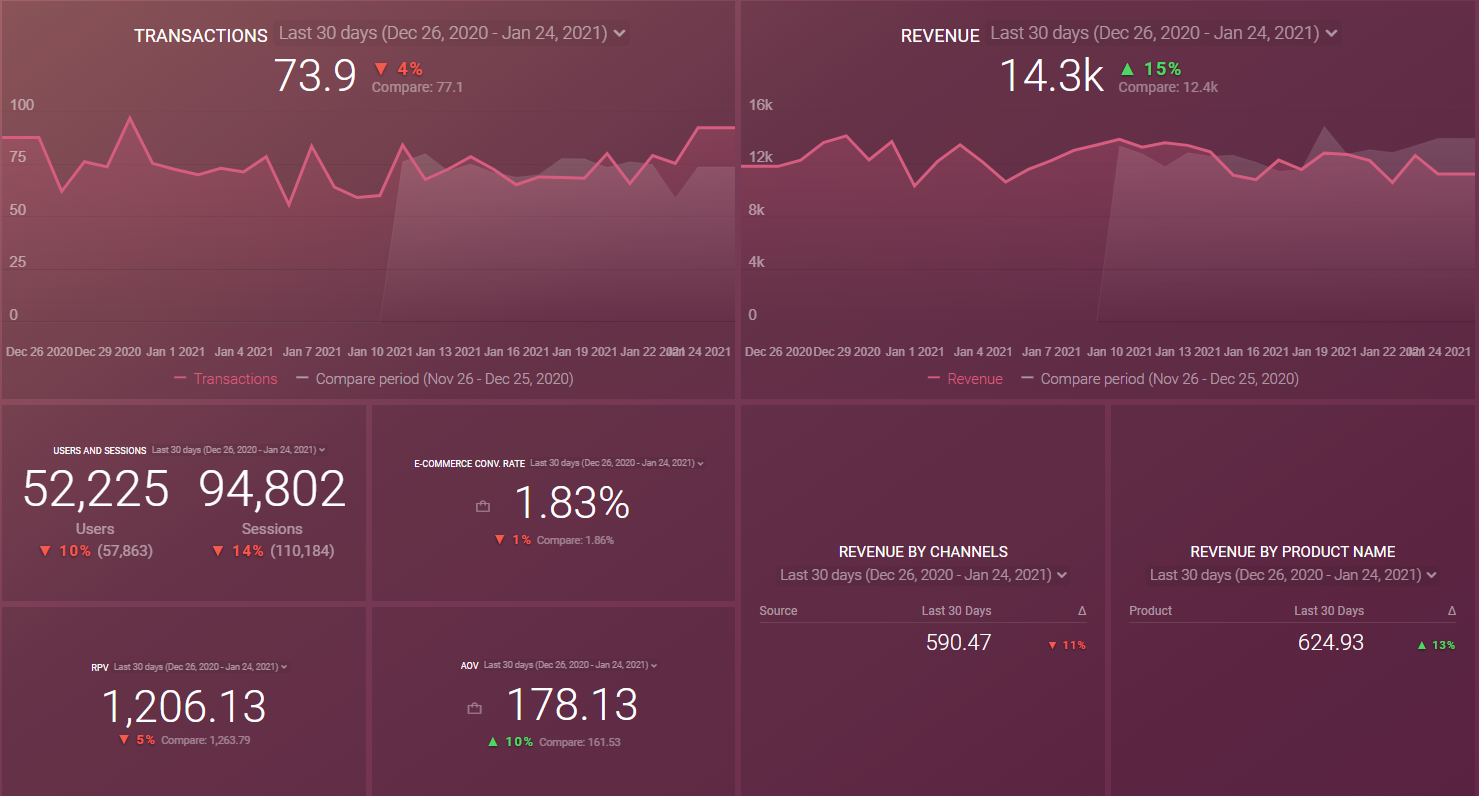 Databox’s reports are also not linked – which means you’ll need to edit them one by one rather than in batch. This can be very time-consuming if you have dozens of similar reports for clients and you need to tweak them.
Databox’s reports are also not linked – which means you’ll need to edit them one by one rather than in batch. This can be very time-consuming if you have dozens of similar reports for clients and you need to tweak them.
Key Features
- 100+ integrations
- Native visualization dashboards and reports
- Dashboard and report templates
- Slack, email, or in-app alerts
- KPI benchmark groups
Databox Reviews from Real Users
“Databox makes it simple to interact with data in ways you never thought possible.” (Source)
“I'm not sure what has happened with the customer support team at Databox but they are fairly unresponsive these days.” (Source)
"After 2 years I left. Templates always break, individual metrics always break, lack of good support." (Source)
Pros and Cons
Pros:
- Easy to use
- Wide variety of integrations
- Interactive data
Cons:
- Slow customer support
- Bugs and lag issues
- Broken metrics and templates
Databox Pricing
Databox offers five different pricing plans as of October 2024:
- Free: Limited to 3 users, data sources, and dashboards. No custom metrics, data calculations, or report automation available.
- Starter: $341/month for 50 data sources, 5 users, and unlimited dashboards.
- Professional: $451/month for 50 data sources, 15 users, and unlimited dashboards. Includes custom metrics and data calculations.
- Growth: $681/month for 50 data sources, and unlimited users and dashboards.
- Premium: $999/month for 100 data sources, and unlimited users and dashboards.
White-labeling and “guided onboarding” is only available as an add-on on Databox ($250 and $500 per month respectively). In contrast, these are included in all of Whatagraph’s pricing plans.
7. Funnel
Most suitable for: Enterprises with dedicated data scientist teams
If you’re looking for a powerful data cleaning and moving tool rather than a reporting tool, Funnel is a great choice.
Funnel.io is a data pipeline tool that pulls data from different sources, transforms it, and ships it to data warehouses, visualization tools, or spreadsheets.
Funnel boasts over 500 data connectors with major marketing analytics tools and CRM systems, such as Hubspot, Salesforce, DV360, and more.
If you don’t see a connector, you can also import your own data using a Google sheet, or request the Funnel team to build one for you.
You can then do custom calculations, make new metrics and dimensions, and blend data sources together to clean and unify your data.
Once your data is cleaned and prepped, you can ship it to destinations like:
- Business intelligence tools: e.g. Tableau, Looker Studio
- Spreadsheets: e.g. Google Sheets, Excel
- Analytics platforms: e.g. Google Analytics, Mixpanel
- Warehouse and storage: e.g. BigQuery, Snowflake
However, Funnel isn’t a reporting tool. Their dashboards are quite basic with limited customization and you can’t share direct reports with external parties. For this, you’ll need to rely on a third-party tool like Tableau or Looker Studio.
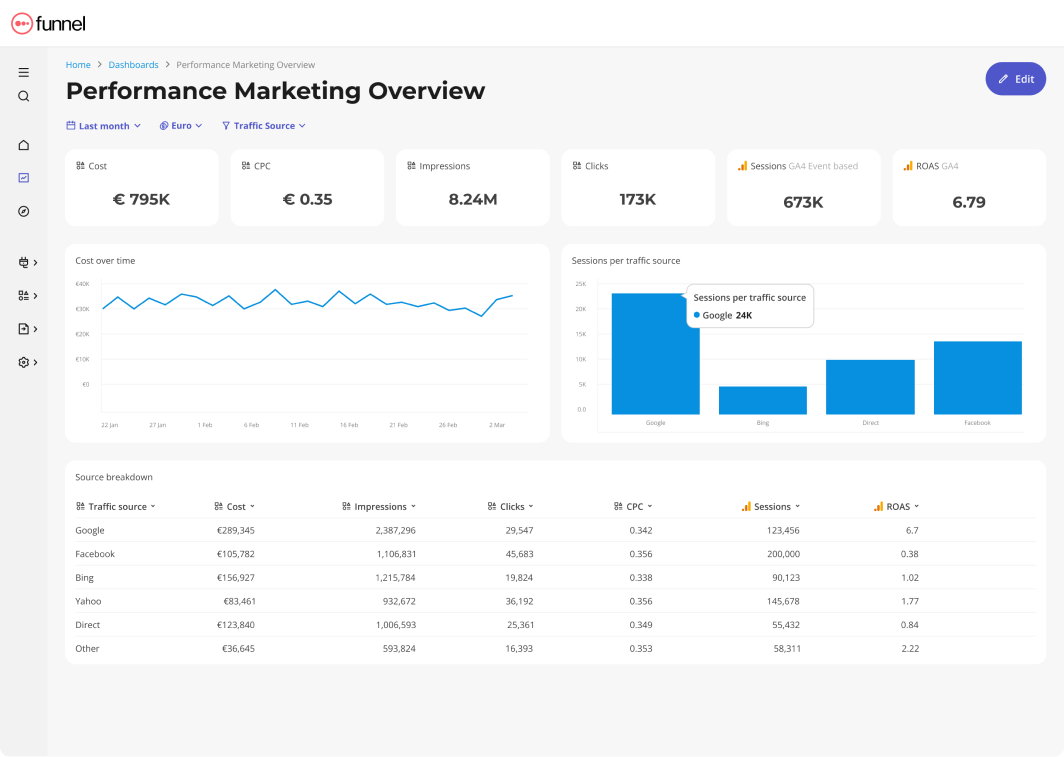
Key Features
- 500+ integrations
- Custom integrations or Google Sheets data import
- Custom dimensions, metrics, and currency conversions
- “Data Explorer” dashboard for data scientists
- Basic visualization dashboards to view key metrics
- Export to data destinations
Funnel Reviews from Real Users
“Funnel does the work of several people, we now couldn't run our business without it.” (Source)
“What I like most about Funnel is how customizable it is. Within their Data Explorer you can look at the data in any way please and any possible configuration.” (Source)
“Takes some time to wrap your head around, and the set up takes some time. Still some bugs in some connectors that haven't been solved after a few months.” (Source)
Pros and Cons
Pros:
- A wide range of connections with all major marketing platforms
- Low-code data organization interface
- Fast and helpful customer support team
Cons:
- Initial steep learning curve
- Occasional bugs in connectors
- Basic native visualization widgets
Pricing
Funnel.io’s pricing model is based on “flexpoints” which are usage credits to add new data connectors, transform data, and move it to destinations.
It offers three distinct pricing plans: Starter, Business, and Enterprise.
- Starter: $1.2 / flexpoint per month. This plan allows you to connect the first 3-5 sources and use 350 flexpoints* for free. It includes 121 core integrations, 3 Core destinations, and the Data Explorer.
- Business: $1.5 / flexpoint per month. Gives you everything in Starter plus 381 additional Business connectors, 37 Business destinations, data source templates, and unlimited workspaces.
- Enterprise: $2.0 / flexpoint per month. The plan designed for organizations operating at scale includes everything in Business plus 11 Enterprise connectors, 1 additional Enterprise destination (Snowflake), data region choice, and technical account management.
But if you need dozens of data sources and destinations, you can expect to pay anywhere between $1500 to $4000 per month.
8. Supermetrics
Most suitable for: Enterprises with dedicated data scientist teams
Supermetrics is a data moving tool that pulls together marketing data from over 150 platforms, like Google Analytics and Facebook Ads, into data warehouses and BI tools like Big Query and Looker Studio.
Compared to DashThis, Supermetrics is a powerful data analytics platform.
With automated normalization, it reduces data redundancies and inconsistencies, making sure your data is clean. Supermetrics also offer “Custom Fields” which let you define how your data appears, whether you’re enriching existing metrics or creating new ones.
You can also combine data from various marketing platforms to get a unified view of your performance.
However, the drawback is that you’ll need to have a technical background or a dedicated data scientist to use data mapping and transformations.
In contrast, on Whatagraph, you can organize your data any way you want and create custom blends, metrics, and dimensions in seconds using simple workflows.
Supermetrics also doesn’t come with native visualization dashboards. If you want to visualize your data and create reports, you’ll need to ship it to a BI tool like Looker Studio. This creates more work and headaches as you’ll now need to learn how to create dashboards in Looker Studio.
And while Supermetrics and Looker Studio reports look like glorified spreadsheets, Whatagraph’s look clean, neat, and appealing.

Key Features
- 150+ integrations
- Automated normalization, custom fields, and data blending
- Data storage in-house or in an external data warehouse
- AI data summaries
- Conversion events uploader from both online and offline sources directly to marketing platforms
- Data transfers to BI tools, data warehouses, and spreadsheets
Supermetrics Reviews from Real Users
“Thanks to Supermetrics we were able to create a single dashboard for all our channels and now we can compare cost, clicks, impressions, conversions across all our channels.” (Source)
“I find the steeper learning curve associated with Supermetrics to be a bit challenging. “ (Source)
“Loading time for large amounts of data can take some time. I feel like that is more of a Looker issue than a Supermetrics issue mostly.” (Source)
Pros and Cons
Pros:
- Simple and easy to use
- Automated no-code data transfers
- Easy historical data retrieval
Cons:
- Loading data to multiple destinations is not available with a single pricing plan
- Adding more data sources requires buying more connectors
- Looker Studio connector can get slow when connected to multiple ad accounts
Pricing
Supermetrics offers pricing plans based on the final destination and the number of data sources you want to connect. However, for most plans, you must contact their sales to get quotes.
9. Adverity
Most suitable for: Data teams in agencies or brands
Adverity is an integrated no-code data platform that you can use to connect to various data sources, cleanse this data, and share it with destinations and teams of your choice.
It uses data connectors and API-like connectors to process any type of data or format. You can also upload custom data using spreadsheets, Excel files, .json, or .xml files.
Once the data is on the platform, you can use Adverity’s transformation engine to clean, normalize, and unify it to create a clean data stack. This data is then visualization-ready.
Adverity does come with a basic dashboard called “Data Explorer” where you can visualize your data in charts and graphs. However, you need to create every dashboard from scratch and there aren’t many customization or white-labeling options available.
Like Funnel, you’ll need to rely on a third-party visualization tool like Looker Studio to get custom reports.
Key Features
- 600+ pre-built connectors
- Custom integrations via spreadsheets, Excel files, .json, or .xml files
- Data transfer to databases and data lakes
- AI-powered data transformation engine
- Built-in data governance
- Data Explorer dashboard
Adverity Reviews from Real Users
“Adverity has a very easy and user-friendly user interface to navigate throughout the entire system.” (Source)
“The passive destination with Google Data Studio is not helping to show the data easily.” (Source)
“The one thing that I don't like about the Adverity is that it has less documentation which most of the time causing confusion about how to use the Adverity.” (Source)
Pros and Cons
Pros:
- No-code ETL transfers
- Predefined data transformation
- A large number of sources and destinations
Cons:
- Difficulty to use and set up
- Basic dashboards and reports
- Even the basic pricing may be too expensive
Pricing
Adverity’s pricing is hidden behind a “Contact Us” wall, but as of 2022, the company said their pricing starts from 1500 Euros a month.
Test use cases we’ve run at Whatagraph show Adverity is at least 50% to 60% more expensive than us, while not including visualization and custom reports.
10. Improvado
Most suitable for: Data teams and marketing teams at large companies
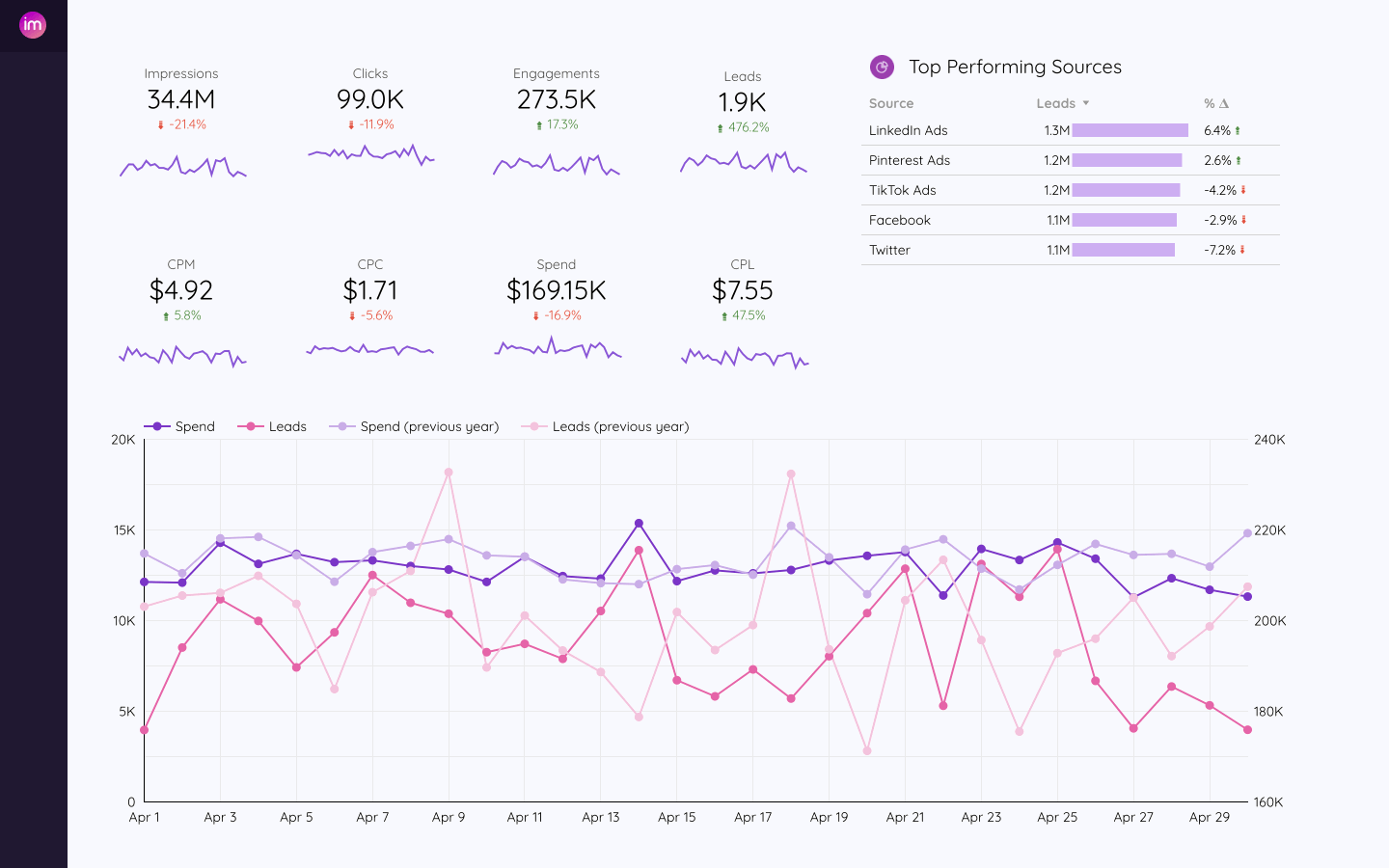
Improvado is an end-to-end data pipeline platform that gathers data from marketing platforms, MarTech tools, and CRMs, transforms this data, and ships it to various destinations.
You can integrate with over 500 channels and harmonize and clean your data into an unified dataset.
You can then push this cleaned data to visualization tools, data warehouses, and spreadsheets. You can also keep your data in a fully-managed storage.
Similar to Supermetrics and other ETL tools, you’ll still need to move your data from Improvado to a third-party tool like Looker Studio to visualize it.
However, Improvado does offer pre-built dashboards that you can use right away with your visualization tool of your choice. This means you won’t need to spend too much time creating dashboards and reports.
But it can take months to implement Improvado and you’ll need to have strong coding skills to build dashboards. This makes it a more suitable tool for enterprises who need a powerful data analytics platform, but it may be overkill for marketing agencies and small businesses.
Improvado Reviews from Real Users
“There are a lot of ETL tools and a growing amount of AI companies, but Improvado's customer relationships and willingness to go above and beyond really sets them apart.” (Source)
“The best aspect of Improvado is their extensive range of integrations across major social, search, and ad-server platforms.” (Source)
“Improvado can be expensive, particularly for smaller businesses or startups with limited budgets.” (Source)
Key Features
- 500+ integrations
- Fully-managed data storage
- Unlimited data destinations
- Pre-built dashboards
- AI-driven data transformations
- Marketing attribution
- AI-powered campaign governance
- AI-insights
Pros and Cons
Pros:
- Powerful data analytics
- AI-powered insights
- Helpful customer support
Cons:
- Can be expensive for small businesses and agencies
- Long implementation time
- Steep learning curve
Pricing
Improvado doesn’t share their pricing publicly but based on online reviews and blog articles, the total cost can be anywhere between $2,000-$5,000 per month.
11. FiveTran
Most suitable for: Data teams at small to medium businesses
Fivetran is an automated data movement platform that simplifies the process of moving data from various sources to destinations like data warehouses and data lakes.
It supports over 500 connectors, including SaaS applications, databases, and files, ensuring reliable and secure data transfers.
With Fivetran is that you can automate data replication, real-time analytics, and cloud migrations, making it easier to gain insights and drive data-driven decisions.
A unique feature of Fivetran is its automatic schema evolution. This means that Fivetran can automatically detect and adapt to changes in the data structure of your sources.
For example, if a new field is added to a data source, Fivetran will automatically incorporate this change into your data pipeline without requiring manual intervention. This make sure that your data remains consistent and up-to-date, even as the structure of your source data evolves over time.
The platform also offers different deployment models to meet various business and security needs, from fully-managed cloud solutions to on-premises setups.
Key Features
- Vast library of data integrations
- Complete replication from any source
- Fully managed pipeline 24x7
- Normalized schemas from denormalized APIs
- Automatic schema migrations
FiveTran Reviews from Real Users
“Fivetran has provided us with a no code solution to extracting data into our databases and data warehouses, and has hugely simplified our data architecture and improved security.” (Source)
“Relying on Fivetran means depending on a third-party service for critical data workflows. If there are outages or issues on their end, it could impact your data integration processes.” (Source)
“Support could be so much more better.” (Source)
Pros and Cons
Pros:
- No-code marketing analytics platform
- Automated data transformation
- Data governance and security features
Cons:
- Time-consuming logging process
- Lacks enterprise-oriented data management features
- Limited support for historical data ingestion
Pricing
Fivetran comes with four pricing plans including the Free plan that includes all the features of the most popular Standard plan but with a usage limit of 500,000 monthly active rows.
It’s meant for users who need to automate ETL for small amounts of data. Other plans are graded by the number of users, sync time, and advanced data features.

WRITTEN BY
YamonYamon is a Senior Content Marketing Manager at Whatagraph. Previously a Head of Content at a marketing agency, she has led content programs for 5+ B2B SaaS companies in the span of three years. With an eye for detail and a knack for always considering context, audience, and business goals to guide the narrative, she's on a mission to create genuinely helpful content for marketers. When she’s not working, she’s hiking, meditating, or practicing yoga.